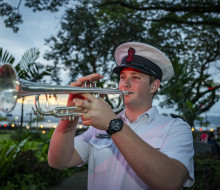
Taupō trumpeter in demand in brand new career with Royal New Zealand Navy Band
26 August 2025
Unfortunately you are viewing this website on an outdated browser which does not support the necessary features for us to provide an adequate experience. Please switch to a modern browser such as latest version of Google Chrome, Mozilla Firefox, Apple Safari or Microsoft Edge.
Ngā mihi nui
The Antarctic conditions can be bearable at the height of the summer season, but when Royal New Zealand Air Force (RNZAF) Flight Lieutenant Carter Bland arrived on a supply flight in the dying days of winter the -40°C temperature was excruciating.
“You just didn’t want to go outside in that shocking weather. I put my hand out the window and decided to stay inside the plane.”
The RNZAF No. 40 Squadron navigator from Auckland has flown south to Antarctica seven or eight times in the C-130H Hercules as part of the support for scientific research. The fleet flew its last flights to Antarctica in the new C-130J Hercules this summer season, which has now come to an end.
Part of a navigator’s main role is to manage the fuel and working out the flight’s point of safe return.
“In the mornings I would run a lot of plans working out different scenarios we would be able to turn around, and draw up a graph for that and keep an eye on it.
“In flight at specific coordinates I would log the fuel and the fuel burn and adjust the point of safe return as we go, so we have a more accurate point – usually we end up saving some fuel along the way making the location closer to Antarctica,” Flight Lieutenant Bland said.
“There are a lot of safety processes in place, but it can be daunting knowing if you make a mistake on the fuel graph, it could be a big problem.”
When Flight Lieutenant Bland flew to the ice for the first time he was “awestruck”.
“I was looking at the blue ocean and then some icebergs and the next thing you know the whole scenery is covered in white and you’ve never seen anything like it – it’s quite an incredible sight.
“Seeing the mountains and they seem pretty big, but then you realise how far away they are and how massive they must be. It’s very humbling to see that.”
He experienced first-hand what it would be like to try to survive in the desolateness of the terrain by completing the extreme cold weather survival course, sleeping overnight in a tent and snow cave.
“It’s not anything you’re used to – you’ve got so many layers on and you’re trying to do the work and you’re freezing cold and then you’re just looking forward to getting into your sleeping bag to stay warm.
“The light is confusing and disorientating because it’s so bright even though it’s the middle of the night and you’re trying to sleep and you have no concept of the time. It’s challenging conditions to try to survive in,” he said.
“It definitely made me appreciate the early explorers and wonder how they did it with the technology they had at the time. Now we have tents and sleeping bags that are so well designed. We had a look at Scott’s hut and it was unbelievable seeing the things they used to live in down there.”
Flight Lieutenant Bland was pleased to be part of the operation supporting scientific research in the remote region by being part of the team to deliver equipment and supplies.
“It’s a pretty good feeling and it’s great to be part of such a long legacy and being part of the last few flights of the C-130H down there. Those last flights were pretty special.”